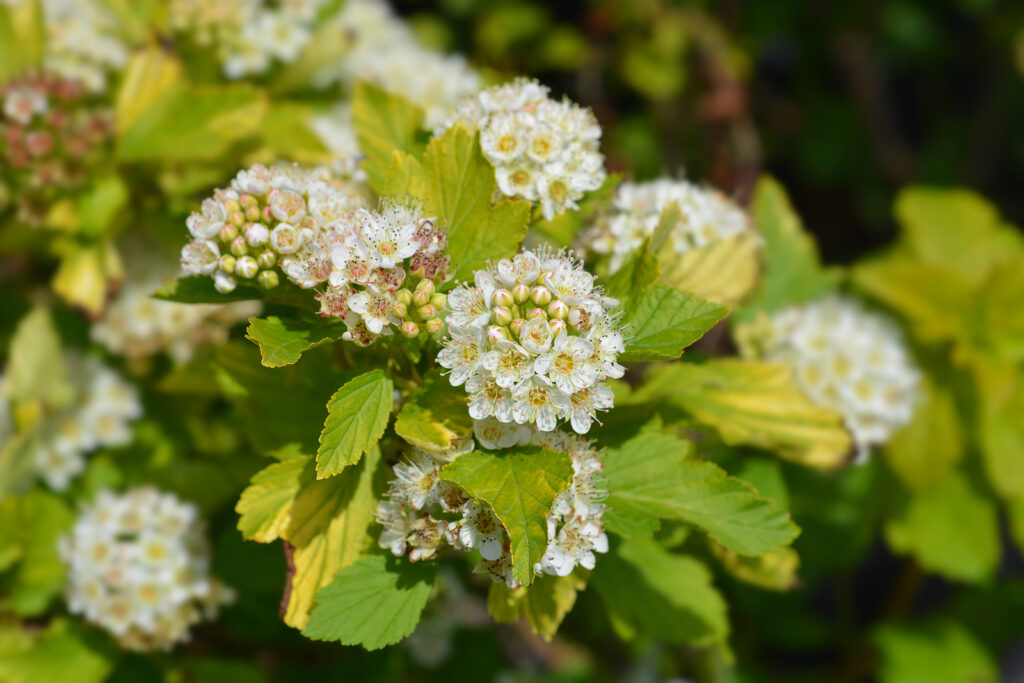Physocarpus — commonly called Ninebark –is a deciduous shrub that bears round clusters of tiny white or pinkish flowers in spring or early summer. Physocarpus common name ninebarks come from its peeling bark, which strips off to reveal several layers.
Physocarpus leaves look like the leaves of the currant plant. The flowers resemble the flowers of spirea or a scaled-down snowball viburnum.
Physocarpus is a spring-blooming addition to a shrub border. It is easy to grow and the bark and seed capsules that follow the flowers provide winter interest.
Physocarpus is a genus of about 10 species of deciduous shrubs that are native to thickets and rocky slopes in Eastern Asia and North America.

Get to know Physocarpus
- Plant type: Deciduous shrub
- Growing zones and range: Zones 2 to 7
- Hardiness: Hardy to Zone 2
- Height and width: 4-9 feet (1.2-2.7m) tall and just as wide
- Growth rate: Fast
- Form and habit: Upright to spreading
- Foliage: 3-lobed, 1.5-3 inches (3.8-7.6cm) long, to 1.5 inches (3.8cm) wide, emerging yellow, fading to lime and green; leaves look like currant leaves; interesting shedding bark that peels off in papery strips
- Flowers: Pink-white, .3 inches (.8cm) across in upright clusters, resembling the related spirea, or perhaps a scaled-down snowball viburnum.
- Fruits: Small, inflated pods
- Bloom time: Late spring
- Uses: Shrub border, informal hedge, naturalized in open woodlands; makes a good filler in a green grove.
- Common name: Ninebark
- Botanical name: Physocarpus
- Family name: Rosaceae
- Origin: Rocky slopes of Eastern Asia and North America
Where to plant Physocarpus
- Plant Physocarpus in full sun to partial shade.
- Plant Physocarpus in humus-rich, well-drained soil; Physocarpus adapts to acid or alkaline soil.
When to plant Physocarpus
- Physocarpus transplants easily in early spring or fall.
- Sow seeds in spring or autumn.
Planting and spacing Physocarpus
- Space Physocarpys 4 to 9 feet (1.2-2.7m) apart depending on the variety.
- Sow seed 1/4 inch deep in evenly prepared soil.
How to water and feed Physocarpus
- Give Physocarpus regular to moderate water. Established plants can tolerate dry conditions.
- Feed Physocarpus with an all-purpose, organic fertilizer in spring.

How to prune and care for Physocarpus
- Cut old Physocarpus wood to the ground in late winter.
- To keep it vigorous, cut back Physocarpus of older wood to the ground or back to an outward facing bud, right after flowering.
- Thin out young Physocarpus shoots if they become crowded.
Physocarpus pests and diseases
- Physocarpyus can suffer from leaf spot, fireblight, powdery mildew, and witches’ broom.
Physocarpus propagation
- Propagate Physocarpus from seeds in containers outdoors in spring or autumn.
- Take greenwood cuttings in summer.
- Remove rooted suckers in autumn or spring.
Physocarpus varieties to grow
- Physocarput capitatus, native to mountainous northwest United States, this species grows to 8 feet (2.4m) tall and bears 2 inch (5.1cm) three-lobed leaves similar to a currant’s and 2-inch (5.1cm) rounded clusters of white flowers. Prefers moisture-retentive soil. Zones 5 to 7.
- P. monogynus, Mountain Nineback, this relatively diminutive species native from Texas to South Dakota average 3 feet (.9m) tall and wide and has toothed, lobed leaves to 1.5 inches (3.8cm) long. The late spring flower clusters, which have fewer blooms than other species, are followed by reddish seed capsules that are touched with green. Zones 5 to 7.
- P. opulifolius, Ninebark, native to roughly the northeastern quadrant of the country and north into Quebec, ninebark grows 6-10 feet (1.8-3.1m) tall and wide. The leaves, which usually have three to five lobes, turn yellow or bronze in fall. Balls of small white flowers, with pink-tinged petals and stamens, tipped with purple, bloom in late spring, followed in fall by reddish seed capsules (follicles). Its exfoliating bark is interesting in winter although often hidden.
- ‘Dart’s Gold’, the most ornate eastern ninebark, an upright 4-9 foot (1.2-2.7m) with masses of small pink-to-white flowers that are produced in May or early June to give the plant the appearance of large spirea. The flowers are followed by reddish fruits that change to cinnamon brown and remain on the plant in winter. More refined and compact than the species, with bright yellow leaves early in the season that looks like a mass of yellow flowers. As the season advances, the foliage turns lime green, and then green.
- ‘Diablo’ has reddish-purple foliage.
- ‘Luteus’ bears yellow-green leaves and grows to 8 feet (2.4m) or more.















